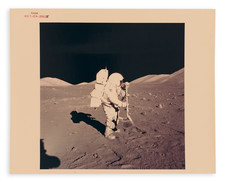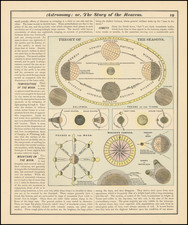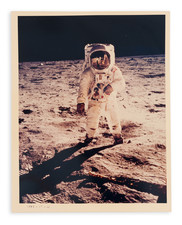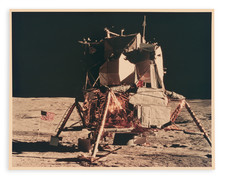An Apollo Mission 15 Lunar Photography Index Map, Sheet 5 of 10, produced under the direction of the Department of Defense by the Aeronautical Chart and Information Center for the National Aeronautics and Space Administration in its first edition from March 1, 1972, offers a detailed visual documentation of lunar topography from the iconic mission. With precise photographic measurements and reference to a myriad of frames, this map furnishes not only geographical data but also historical insights into the U.S. space exploration during the early 1970s.
The 1970s marked an epoch in human history where our species took its initial, tentative steps into space, venturing beyond our home planet. The Apollo 15 mission, a part of NASA's broader objective to explore and understand the moon, played a vital role in this era. Such lunar maps, especially one as intricate as this, encapsulated the rigorous preparation and meticulous data collection undertaken to ensure the safety and success of the mission, while also expanding humanity's understanding of Earth's satellite.
The color-coded references in the map, ranging from purple to red, denote specific orbital revolutions and the frames captured during those orbits. These specifics, detailing sun elevation, orbital altitude, and camera tilt and azimuth angles, showcase the technical precision of the mission. In addition to the photographic data, this map is enriched with toponyms and detailed lunar topography, enabling a comprehensive understanding of specific areas of the lunar surface.
Another intriguing aspect of this map lies in its preparation. Organized under the direction of the Department of Defense and lithographed by the Aeronautical Chart and Information Center, this collaboration between military and civilian agencies elucidates the multidisciplinary efforts that went into the Apollo missions. It underscores the unity of purpose in the U.S. during the Space Race, drawing resources and expertise from various quarters.
In conclusion, An Apollo Mission 15 Lunar Photography Index Map is more than just a technical document; it stands as a testament to human endeavor and the insatiable drive to explore the unknown. It offers readers an intimate glance into the intricate processes and collaborations of the historic Apollo 15 mission and serves as a reminder of our species' incredible achievement in space exploration.
The Apollo 15 mission was the fourth voyage to the moon and the first "J mission," missions that spent slightly longer on the moon. This mission represented a shift towards scientific observations, though it was also marred in public opinion due to several scandals and incidents.
The mission was crewed by David Scott, James Irwin, and Alfred Worden. These three were all accomplished pilots, and they constituted the first crew to land on the moon who were all interested in scientific exploration. Stuart Roosa had attempted to make extensive scientific observations during Apollo 14, but the lack of interest from Alan Shepherd hampered his effort. Apollo 13 had similar objectives to Apollo 15 but did not land. The J mission structure was also better suited for longer periods of observations, and all of these factors contributed to one of the most successful Apollo missions.
As the three crewmembers had trained as the backup crew for Apollo 12, they were well prepared to fly and so could spend more time preparing their scientific experiments, in particular those that related to the subject of geology. Caltech geologist Lee Silver was in charge of teaching useful skills to Scott and Irwin, who would land, while lead Apollo Program geologist Farouk El-Baz taught Worden, who would remain in orbit. The three went on increasingly complex geological field trips where they made joint ground and areal observations, which would be relayed through CAPCOM to geologists unfamiliar with the area. The three went on twenty monthly field trips prior to launching.
The mission landed at Hadley Rille located on the east side of the Mare Imbrium. The area is a deep channel bounded by the five-kilometer high Montes Apenninus. This area was particularly difficult to land at which coupled with the new thruster systems to make for a hard and off-kilter landing. Once landed, the crew made a series of three EVA over a sixty-seven hour period on the mon's surface.
The many different observations made during this voyage would contribute to scientific progress in a lot of different ways. The field observations made helped to constrain the relative ages of various structures in the area, as well as determine more about how they came about. Of particular interest were the many breccias and flow deposits discovered, apparently from the Apennine Mountains. These provided constraints on the orogenic history of the structure. In addition to field observations, the astronauts brought various instruments to help them better understand the geology of the area and were even able to extract a core sample, albeit with much difficulty.
One of the samples collected was named the "genesis rock," which had an evolved composition and was originally believed to be part of the moon's primordial crust, although later dating showed it was only 4.1 billion years old, while the moon would have formed around 4.51 billion years ago. The sample still has some interest as the samarium-neodymium age, which records extractive processes that the source material of the rock went through, suggests an age of 4.46 billion years for the appearance of evolved lunar rocks.
While the mission completed its many scientific objectives, two main incidents tarnished the crew in the eyes of NASA. The first was the issue regarding a "Fallen Astronaut" memorial, in which the crew left a plaque with the names of fourteen American and Soviet pilots who died due to space exploration, alongside a small statuette. The artist who created this work later tried to sell some copies of his statue, claiming that he had been given permission to do so even though NASA regulations prevented the use of the space program for private economic gain. The second issue involved the astronauts taking a collection of four hundred unauthorized postal covers into space, one hundred of which were later sold in West Germany at a large profit. While this was common practice in earlier missions and not technically against the rules, the newspaper discovery of this incident led to House and Senate hearings. The three astronauts would never fly again.















![Mission to the Red Planet [on verso:] Space Quest](https://storage.googleapis.com/raremaps/img/small/95754.jpg)
